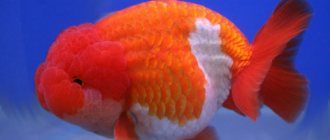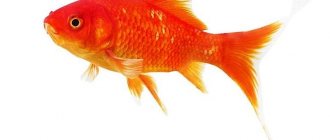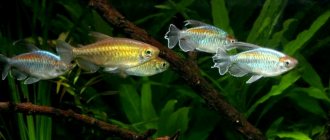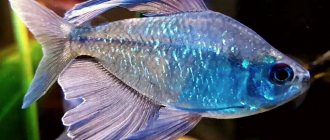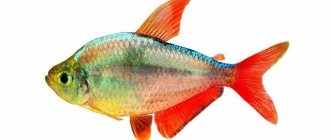The copper tetra, or Hasemania Nana, is popular among aquarists due to its ease of care and reproduction. Tetra belongs to the characin family, which includes more than 1,200 species of fish. The oldest characins were found in warm fresh waters at the turn of the Ice Age - in the Upper Miocene. The first description of the copper tetra was made by the Danish zoologist H.F. Lütken in 1875. They appeared in European aquariums in the 30s of the twentieth century and have not lost popularity to this day.
Natural habitat
These bright, playful fish are found in the streams and tributaries of the St. Francis River, the largest waterway in the northeastern region of South America. The fish avoids the main riverbed, crossed by rapids and waterfalls, and prefers warm waters with a slow flow.
Backwaters and channels abound with flooded tree trunks and a thick layer of fallen leaves, which gives the water a light tea color, but these fish are also found in light waters. Dense vegetation on the banks and abundant organic residues change the chemical composition of the water and create a diverse tropism.
The bottom of these streams and rivulets is sandy with sparse vegetation. When creating an aquarium for the copper tetra, it is not necessary to plant plants. Driftwood scattered along the bottom will help recreate a natural biotope, and dried oak or beech leaves floating on the surface will create the necessary shading for the fish. It is this background and color of the water that allows the copper shine of the tetra to appear more fully.
Conditions of detention
To create optimal conditions for the copper Tetra, you should purchase a spacious oblong-shaped aquarium. Her body size is 4-6 centimeters. It is better to keep Copper Tetras in a flock of at least 8 individuals. Then it will behave naturally in an aquarium. And watching a flock of copper Tetras is much more interesting. It looks great against the backdrop of living plants. It is better to take dark soil for an aquarium, and driftwood is suitable as a natural habitat.
Typically, these fish spend a lot of time in the middle and upper layers of aquarium water. This fish is very active. Sometimes, after playing too much, he may jump out of the aquarium. To avoid such situations, you should cover the fish house with a lid. As for water parameters, it is better to maintain the following: temperature - up to 26°C, acidity - up to 7.5 pH, hardness - up to 20°. To create such conditions, special aquarium chemistry is suitable. It is inexpensive and makes caring for the fish house easier.
Another important condition for keeping copper Tetras is the presence of a high-quality filter for the aquarium and aeration. It is recommended to change a third of the water weekly with fresh water. Copper Tetras love clean water.
Feeding the fish is not difficult. Copper Tetras, like other Characin species, are not picky eaters.
Bloodworms and tubifex, daphnia and frozen food, high-quality dry food are perfect for the diet. The main condition of nutrition is not to overfeed the copper Tetra and not to feed it monotonously.
Since this is a peaceful fish, it will feel comfortable with peaceful neighbors. Rhodostomuses and glass Tetra, Ternetia will be good company for her.
Appearance
Hasemania nana is a small fish. Even in the natural environment, it reaches a size of 3-5 cm. The body is elongated, laterally flattened, and high. Unlike most characin species, the copper tetra lacks an adipose fin.
Another interesting feature of this family is the presence of a Weberian organ. This is a chain of small bones located between the inner ear and the swim bladder. It helps fish detect high-frequency sounds. The copper tetra has excellent hearing and can detect sounds in the range of 13 kHz, while fish that do not have a Weberian apparatus perceive sounds only up to 2.5 kHz.
The water in the fish’s habitat is not rich in oxygen due to the abundance of rotting plant debris and slow flow. Therefore, it is useful to have an additional respiratory organ - a swim bladder of a special structure. It has a significant absorbent surface and a dense network of capillaries that carries oxygen throughout the body. With oxygen deficiency, the proportion of skin respiration also increases. For tetras living in “black waters” it is 20-60%.
The eyes of the copper tetra are large, mobile, and moderately convex. The jaws are strong. The lower jaw protrudes beyond the upper jaw - this type of arrangement of the oral opening is called the “upper mouth”, which is due to the type of nutrition and habitat. The fish feed in the middle layers of water and eat food that has not yet sunk to the ground. Tetra is a pelagic fish.
The color of the fish is interesting. Males have a brighter body color, varying from bluish to silver. Females have a more modest color - greenish-yellow. During the spawning period, the scales have a copper sheen, which is why the fish is called the copper tetra. The intensity of the color depends on physical activity and time of day. In a calm state, during sleep, the color fades and turns silver. The more actively the fish moves, the brighter the body color. This feature is due to the activity of metabolic processes.
From the pectoral to the caudal fin there is a dark stripe along the midline of the body, and above it there is a stripe of bright gold or yellow color. The tips of the unpaired fins of the copper tetra are white, so the fish has another name for the Weber's organ, Silvertip tetra.
The main background of the fins is red-brown in males and yellowish in females. Sexual dimorphism is also noticeable in body shape. Females have a more rounded body with a pronounced belly, and they are larger in size than males. The maximum body length of an aquarium female is up to 5 cm, and that of a male is 2.5-3 cm. With proper care, the copper tetra lives for about 3 years.
Conditions of detention
Hasemania, or as it is also called, the copper tetra, is an active, peaceful and schooling fish that should be kept in a school of 8 or more individuals. Small, peaceful aquarium fish are suitable for keeping together. Prefers to stay in the middle layer of water. The length of an aquarium suitable for keeping copper tetras should be more than 60 cm in length, and also have thickets of aquarium plants, including those floating on the surface of the water, this allows you to create shady places. In addition, you should take care of the free space that is necessary for swimming. Optimal maintenance conditions should have the following parameters: water temperature – 20–26 °C, hardness – 5–20 °, pH – 6.5–7.5. The aquarium should be provided with filtration, aeration and weekly water changes - 1/5 of the total volume. Live food and its substitutes are suitable for feeding fish. The tetra's color becomes more intense when it eats daphnia and cyclops (live and frozen). It is not advisable to feed the tubifex as food.
Editorial: Mexican oak
Aquarium setup
Although the copper tetra is small in size, it is very active and requires a lot of free space to be comfortable. This is a schooling fish that thrives in a group. A loner can behave aggressively if the neighbors in the aquarium are the same size as her, and timid if they are large. Therefore, it is recommended to introduce a school of fish of at least 5-6 into the aquarium.
The volume of the reservoir should be 60 cm x 37.5 cm x 30 cm or 70 liters for a school of 6-10 fish. Comfortable conditions of detention are:
| Characteristics | Options | Unit |
| temperature | 23-28 | °C |
| acidity | 6,0-8,0 | pH |
| rigidity | 5-20 | dH |
A prerequisite is good aeration and water filtration.
Water changes are carried out weekly at least 15-25% of the volume.
In nature, fish live in soft water with low acidity, since the high content of organic remains changes the chemistry of the environment.
For the substrate it is better to use black quartz soil. It does not change the characteristics of water and has a rounded particle surface. Plants are optional, but tetras love to frolic among plants with small leaves. They can be planted along the walls of the container, leaving the central part free.
At the bottom you need to place driftwood, branches, alder nuts, and shade the light with well-dried leaves of oak, ketapang (Indian almond), beech or floating plants. Dry leaves contain a large amount of tannins, which color the water tea-colored, have an antibacterial effect and reduce acidity levels. In “black” water against the background of dark soil, the copper tetra looks very impressive.
The copper tetra is not picky about the characteristics of the aquatic environment, but changes must occur gradually. Changes in temperature, hardness and acidity can stimulate or slow down sexual maturation and reproduction.
Content
The copper tetra is hardy and unpretentious, and it is not difficult to create suitable conditions for it:
- Like other characins, the copper tetra is a schooling fish that feels most comfortable in the company of its relatives. In order for each individual to feel confident, stress less and live longer, it is recommended to start a group of 6-10 tails.
- Despite the relatively small size (an adult is 2-5 cm) of the fish, they need a large amount of free space for swimming. For a flock of 10-20 individuals, you will need an aquarium of 50-70 liters.
- Oddly enough, the natural biotope of copper tetras with sandy soil does not have much underwater vegetation, so its presence or absence will not make a big difference. However, to imitate it in an aquarium, it is worth adding a few floating branches, root fragments and dried beech or oak leaves. This will help recreate the fish's habitat and provide protection from bright light by dimming it and creating shaded areas. In such lighting, tetras will show their color to the fullest.
Optimal water parameters:
- temperature: 23-28 °C;
- acidity: 6.0-8.0 pH;
- hardness: 5-20 dH;
- changing 15-25% of water weekly;
- Filtration and aeration are required.
Nutrition
In the wild, the copper tetra feeds on small crustaceans, worms and plants. In an aquarium, fish happily eat fresh, frozen and dry food. It is better to give dry food in the form of flakes, as it sinks more slowly. Active, nimble fish pick it up during a dive and with a swift throw catch particles floating on the surface of the water.
They lose interest in food that falls to the bottom. Therefore, you need to calculate the portion so that the fish have time to get enough, and uneaten food does not clog the soil.
You need to feed the fish in small portions, 2-3 times a day.
The following are used as a source of protein:
- bloodworm;
- coretra;
- enchytrea;
- daphnia;
- Cyclops;
- brine shrimp
Experienced aquarists recommend excluding the tubifex from the tetra's diet. Protein is very important for stimulating reproduction and enhancing color intensity.
Diseases
If all maintenance parameters are observed in the aquarium, then the fish do not get sick. Therefore, at the onset of any illness in a tetra, it is necessary to check the correctness of the contents and begin treatment. Most often, you just need to equalize the disturbed parameter and the disease goes away. In more severe cases, treatment with antibiotics is started. The best way to prevent fish from getting sick is prevention. That is, you need to periodically inspect the aquarium and monitor the water parameters. How long do copper tetras live? In good conditions, life expectancy is 4 years.
All types of tetras and hassemania are no exception; they are very easy to keep and breed. Therefore, they are suitable for beginner fish lovers.
Compatibility with other inhabitants
The copper tetra is one of the most peaceful fish in the characin family. She gets along well with any inhabitants of the home pond. It will make a good neighborhood:
- small characin fish;
- rainbows;
- lalius;
- rasboram;
- gourami;
- scalars;
- barbs;
- discus;
- African and banana filter feeders;
- cherry shrimp;
- Amano shrimp.
You should not house Hasemania Nana with species of aggressive fish of superior size:
- astronotuses;
- labeo;
- ancistrus;
- tetradons;
- cichlids.
Large fish may mistake the copper tetra for food and attack. When living together, you should take into account the type of food, mobility, size, aggressiveness, water characteristics and environmental temperature. Aquariums where fish live in different layers of water look good - this way they will not compete and irritate each other. Bottom fish:
- armored catfish or corydoras;
- chain catfish;
- battles;
- gastromyzons.
You should not house the copper tetra with veiled-tailed fish. Nimble Hasemanias can bite delicate fins. Although each fish has its own character, and sometimes “scoundrels” peacefully coexist with completely loyal relatives. And a change in conditions of detention can lead to aggression of the peace-loving inhabitants of the aquatic environment.
Content
It should be kept in an aquarium with a large number of plants and preferably dark soil. You need to put floating plants on the surface of the water, put dry leaves on the bottom, and decorate the aquarium itself with driftwood.
They spend a lot of time among the thickets, they can also spawn in them, and if there are no other fish in the aquarium, the fry will grow, since the bacteria that decompose dry leaves at the bottom serve as an excellent starting food.
Amanda's tetra loves water with an acidity of about pH 6.6, and although in nature it lives in very soft water, it adapts well to other indicators (5-17 dGH).
The recommended temperature for keeping them is 23-29 C. They must be kept in a flock, at least 4-6 pieces, so that they swim together.
They can form schools with other tetras, for example, with neons, but in the presence of much larger fish, they become stressed.
Amanda's tetras live and feed in the water column, and do not take food from the bottom. So it is advisable to keep small catfish with them, such as the pygmy corydoras, so that they eat the leftover food.
Breeding
Sexual maturation of the copper tetra lasts up to 4-6 months. A sexually mature pair is placed in a spawning tank with a volume of 5-15 liters. Tetras can be bred in groups of several pairs. The most brightly colored males and females with a round belly filled with eggs are selected. For group spawning, the volume of the container is increased to 50-60 liters.
Live plants are placed at the bottom - Java moss or cirrus. They can also be replaced with artificial plants or separator mesh. The latter is even preferable, since there is no need to catch eggs. Fertilized eggs will fall through the cells to the bottom, and adult fish will not be able to eat them.
The water in the spawning area is warmer (+24-27°C), softer (up to 8°) and slightly acidic (pH 6.0-6.5). Before being placed in a separate container (2 weeks in advance), the producers are separated by gender (females separately from males) and fed generously with protein food.
Water changes are carried out more often, distilled water is added. This imitates the natural spawning conditions that occur during the rainy season. A pair is placed in the spawning tank in the evening, and in the morning each female lays up to 400 dark brown eggs. The male fertilizes the clutch. It is better to remove the breeders from the spawning grounds.
After 24 hours, small translucent larvae with a grayish tint appear from the eggs. After 4-5 days, their yolk sac dissolves, and the fry begin to actively search for food. The starting food for juvenile copper tetras is “live dust” - ciliates, rotifers, daphnia, and cyclops cultivated under artificial conditions.
As they grow, larger food is added - ground chicken yolk, ground, with a drop of water, or newly hatched brine shrimp. At the age of 2 weeks, the fry are already eating nauplii.
In the early stages of life, larvae and fry are sensitive to light, so the spawning ground must be shaded.
In order for the fry to develop better, it is necessary to change ¼ of the volume of water every 1-2 days. The filter and aerator should not create a strong flow of water - experienced aquarists recommend equipping the spawning tank with a sponge filter with a pneumatic drive.
Bright, active fish - copper tetras, which scurry merrily in the water column in a flock, will decorate the aquarium of a beginner and an experienced aquascaper.
Care and maintenance
An attractive feature of tetra fish is their relatively small size. This means that an aquarium of 30 liters or more will be sufficient for maintenance. It is advisable that it be equipped with a lid, because active tetras are good jumpers.
Fish look best in aquariums designed in a natural style, imitating natural biotopes. Quartz sand or small pebbles are used as soil. It’s better to stay on dark soil; the tetras will look much brighter on it. A variety of stones, grottoes, and driftwood are used as decorations. The latter are not only a good shelter, but also release useful tannins into the water. If sand is chosen as the soil, it is useful to put Indian almond leaves on the bottom. It is better not to place sea shells in the aquarium; they will increase the level of hardness.
It is recommended to plant a large number of live plants, while not forgetting to leave room for the tetras to swim. Fish love dim light, so it is better to plant plants that do not require bright lighting. Vallisneria, cryptocorynes, anubias, mosses and ferns are good choices.
Amanda's tetra in an aquarium with live plants
The aquarium must be equipped with a filter and compressor, as well as a thermostat, because tetras are heat-loving fish. You need to change up to 20% of the water weekly. It is useful to add conditioner with Tetra ToruMin natural peat extract to create the effect of “black” tropical water.
Photo of a copper tetra
Description
Hasemania copperata has a compact size of about 4.5 cm in length. In captivity, she lives 3-4 years. The body is elongated, ellipsoidal, slightly flattened on the sides. The caudal fin is forked with a clearly visible tar-blue stripe and white spots. The main color of the scaly cover is rich copper with a silvery tint.
Tetra hassemania differs from its brothers in the family line by the absence of an adipose fin.
Habitat in nature
Hasemania is a fish that lives in the dark waters of Brazil. It settles in creeks and forest swamps, where there is a large accumulation of fallen leaves, branches and decaying organic matter in the water. This creates a cloudy, tea-colored water environment.


